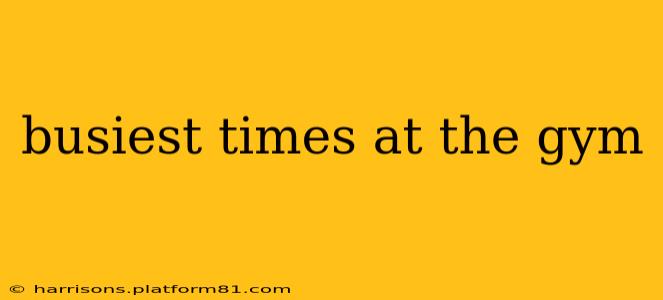Going to the gym can be a fantastic way to improve your health and fitness, but navigating crowded workout spaces can be a major turn-off. Knowing when the gym is least busy is key to maximizing your workout experience and avoiding long waits for equipment. This guide will explore the typical busiest times at the gym, helping you strategize your fitness routine for a more enjoyable and productive experience.
What are the busiest times at the gym?
Generally, the busiest times at the gym fall within the early evenings (5 pm - 8 pm) and immediately after work (noon to 1 pm). This is because many people work during the day and choose to fit their workouts into the limited time they have after work or during their lunch break. Weekends can also see a surge in gym attendance, particularly during the late mornings and early afternoons.
What days are the busiest at the gym?
While it varies based on location and specific gym demographics, Mondays and Tuesdays are often cited as the busiest days of the week. Many people start their fitness goals on a Monday, creating a high demand for gym time. The rest of the week usually sees decreasing crowds, with weekends experiencing a peak again.
Are there less busy times at the gym?
Absolutely! To avoid the peak hours, consider working out during off-peak hours. This generally includes early mornings (before 7 am), late nights (after 9 pm), and mid-day periods (10 am - noon, excluding the lunch rush). Weekday mornings before the work rush are often surprisingly empty.
How can I find the least busy times at my specific gym?
While the above information provides a general overview, the best way to pinpoint the least busy times at your gym is to observe patterns and ask. You can:
- Observe attendance: Visit the gym at different times during the week and note how crowded it is. Try this for a few weeks to establish a clear pattern.
- Check your gym's app (if available): Some gyms offer apps that provide real-time data on gym occupancy or even allow you to book equipment in advance.
- Ask gym staff: The staff are often familiar with the gym's busiest and least busy periods. Don't hesitate to ask for their advice.
What factors influence gym traffic?
Several factors beyond the time of day and day of the week influence gym traffic:
- Time of year: You might find higher attendance during "resolution season" (January) and before summer.
- Holidays: Gym traffic tends to be lower on major holidays.
- Special events: If your gym hosts special events or classes, these periods might be busier.
- Weather: Inclement weather can sometimes decrease gym attendance.
Does the type of gym affect the busiest times?
Yes. Larger, more commercial gyms will often experience busier peak times than smaller, boutique studios or fitness centers. Boutique gyms might have a more consistent flow of traffic throughout the day, while large gyms will see sharper peaks and valleys.
How can I plan my gym visits effectively?
The key to successfully navigating gym crowds is planning.
- Set realistic goals: Don't try to cram too much into one workout session. Prioritize a few key exercises.
- Be flexible: If your usual time slot is busy, try adjusting your schedule by even 30 minutes.
- Utilize off-peak hours: Make the most of those early mornings or late evenings.
- Prepare in advance: Have your workout planned beforehand to minimize time spent searching for equipment.
By understanding the typical busiest times at the gym and using the strategies mentioned above, you can significantly improve your workout experience and make the most of your time at the gym. Remember, consistency is key, but choosing the right time to go can make a big difference in your overall enjoyment and motivation.
